
Hive Audit Trail

Introduction
As organizations increasingly rely on Apache Hive for managing and analyzing vast amounts of structured data, ensuring data security, compliance, and operational transparency becomes crucial. Implementing an effective Hive audit trail helps organizations track user activities, identify unauthorized access, and meet regulatory compliance requirements such as GDPR, HIPAA, and SOC 2.
Understanding Hive Audit Trail
A Hive audit trail is a comprehensive record of events occurring within the Hive environment, including user queries, data modifications, access attempts, and system-level operations. These logs can provide valuable insights into how data is accessed and manipulated, offering a foundation for security, compliance, and performance optimization.
Native Hive Audit Trail Tracking Capabilities
Apache Hive employs three primary logging mechanisms to track system activities: HDFS audit logs for file-level operations, HiveServer2 logs for query execution details, and Metastore logs for metadata changes. Each type serves distinct auditing needs while complementing the others to provide comprehensive system monitoring:
HDFS Audit Logs in Hive Audit Trail
Since Hive relies on HDFS for data storage, HDFS audit logs play a crucial role in tracking file-level operations, enhancing security and compliance efforts.
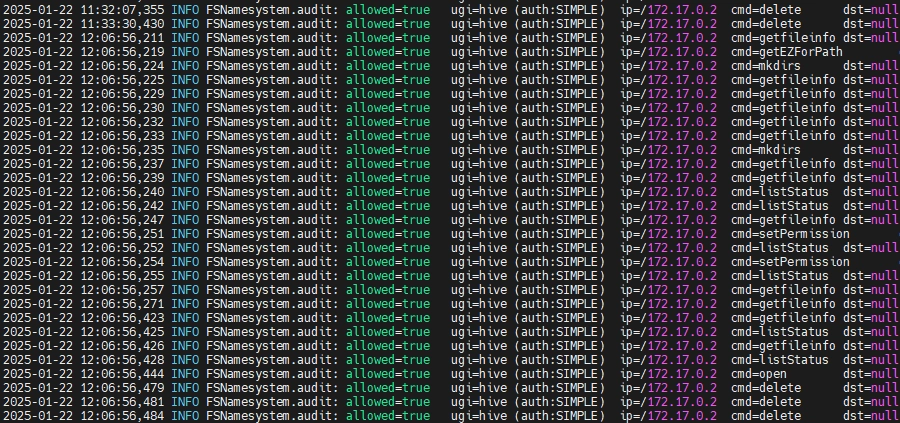
Accessing Logs
HDFS audit logs are typically stored at:
/var/log/hadoop/hdfs/hdfs-audit.log
Common commands to analyze audit logs:
# View entire log
cat /var/log/hadoop/hdfs/hdfs-audit.log
# Search for specific operations
grep "cmd=open" /var/log/hadoop/hdfs/hdfs-audit.log
# Remove the 'src' field and filter for 'hive' for better readability
sed -E 's/\bsrc=[^[:space:]]+[[:space:]]*//g' /var/log/hadoop/hdfs/hdfs-audit.log | grep "hive"
Log Format
Each audit log entry contains structured details in the following format:
timestamp INFO FSNamesystem.audit: allowed=<true/false> ugi=<user> ip=<client_ip> cmd=<operation> src=<path> dst=<path> perm=<permissions> proto=<protocol> callerContext=<context>
Key Audit Insights
HDFS audit logs provide such information as:
- Tracking operations using
HIVE_QUERY_IDandHIVE_SSN_IDfields. - Monitoring file-level actions (e.g., creation, deletion, permission changes).
- Logging user-based activities within the Hadoop ecosystem.
Overall, HDFS audit logs are primarily designed for filesystem troubleshooting and operational monitoring. While they provide insights into file operations and access patterns, they have limited utility for comprehensive security auditing.
HiveServer2 Logs
HiveServer2 logs capture query-level operations and user session information, providing insights into SQL operations and query performance.
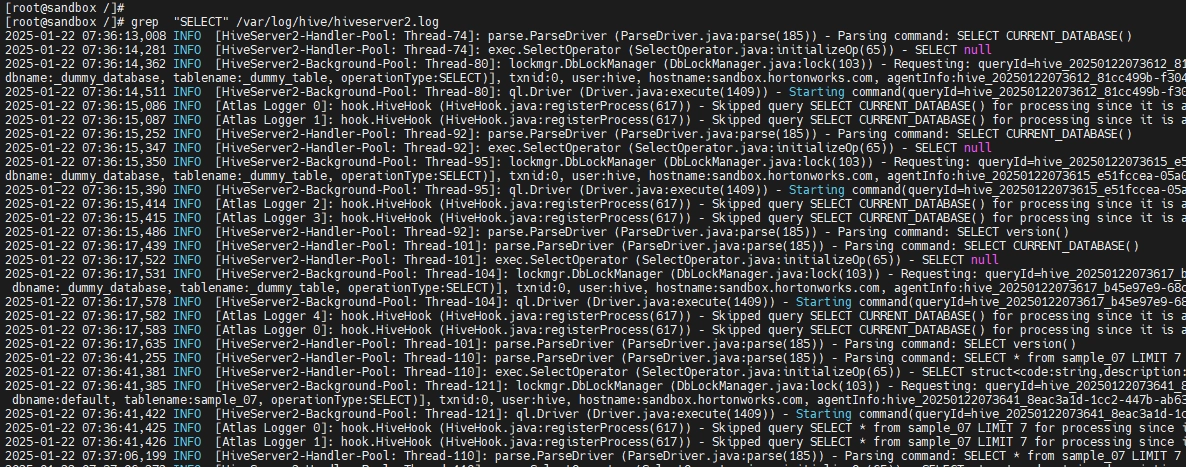
Accessing Logs
Default location in most installations:
/var/log/hive/hiveserver2.log
Common commands for log analysis:
# View entire log
cat /var/log/hive/hiveserver2.log
# Search for specific queries
grep "QUERY:" /var/log/hive/hiveserver2.log
# Format output for better readability
awk '{printf "%-23s %-15s %-10s %-50s\n", $1" "$2, $5, $7, $9}' /var/log/hive/hiveserver2.log`
Log Format
HiveServer2 logs contain detailed information about query execution:
timestamp INFO [SessionState] - Query: <SQL_query> Status: <status> QueryID: <query_id>
Key Audit Insights
HiveServer2 logs provide valuable information about:
- Full SQL query text and execution plans
- Query execution status and duration
- User session management and authentication
- Resource allocation and utilization
- Error messages and query failures
Metastore Audit Logs
Hive Metastore audit logs capture metadata operations such as table creation, deletion, and schema modifications.
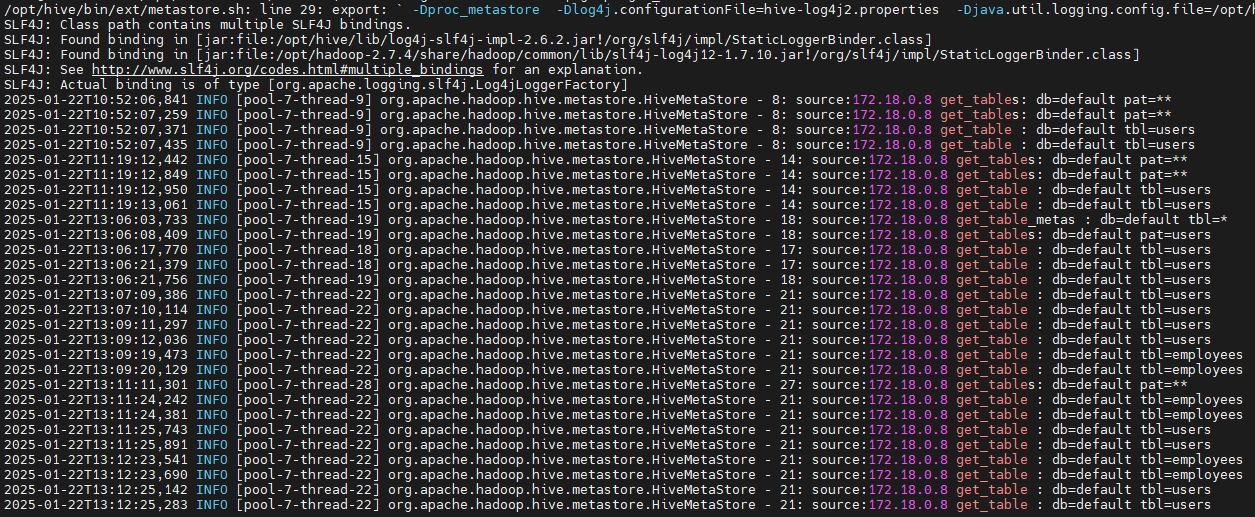
Accessing Logs
Audit logs are typically found at:
/var/log/hive/hive-audit.log
Common commands to analyze Metastore logs:
# View entire log
cat /var/log/hive/hive-audit.log
# Follow log updates in real time
tail -f /var/log/hive/hive-audit.log
# Filter logs by specific operation
grep "get_table" /var/log/hive/hive-audit.log
Log Format
Each entry typically follows this format:
timestamp INFO [thread-info] org.apache.hadoop.hive.metastore.HiveMetaStore - <event-id>: source=<client_ip> <operation>: db=<database> tbl=<table> newtbl=<new_table>
Key Audit Insights
- Captures DDL operations like
CREATE,ALTER, andDROP. - Provides insights into schema modifications and user activity.
- Useful for tracking metadata changes across databases.
Effectively utilizing these logs requires careful planning and may often require additional security and monitoring solutions or integrations with specialized compliance and security focused platforms like DataSunrise to establish a more comprehensive audit framework.
For more information about Hive's logging, you could consult the official Apache Hive documentation.
Hive Audit Trail in DataSunrise
DataSunrise streamlines Hive auditing by consolidating logs from multiple sources into a single, comprehensive audit trail. Unlike native solutions that produce high-volume, low-context data, DataSunrise captures business-relevant audit events with detailed context. Its reverse-proxy integration transforms raw Hive logs into actionable audit trails, supporting security, compliance, and operational requirements while ensuring efficient storage and minimal performance impact.
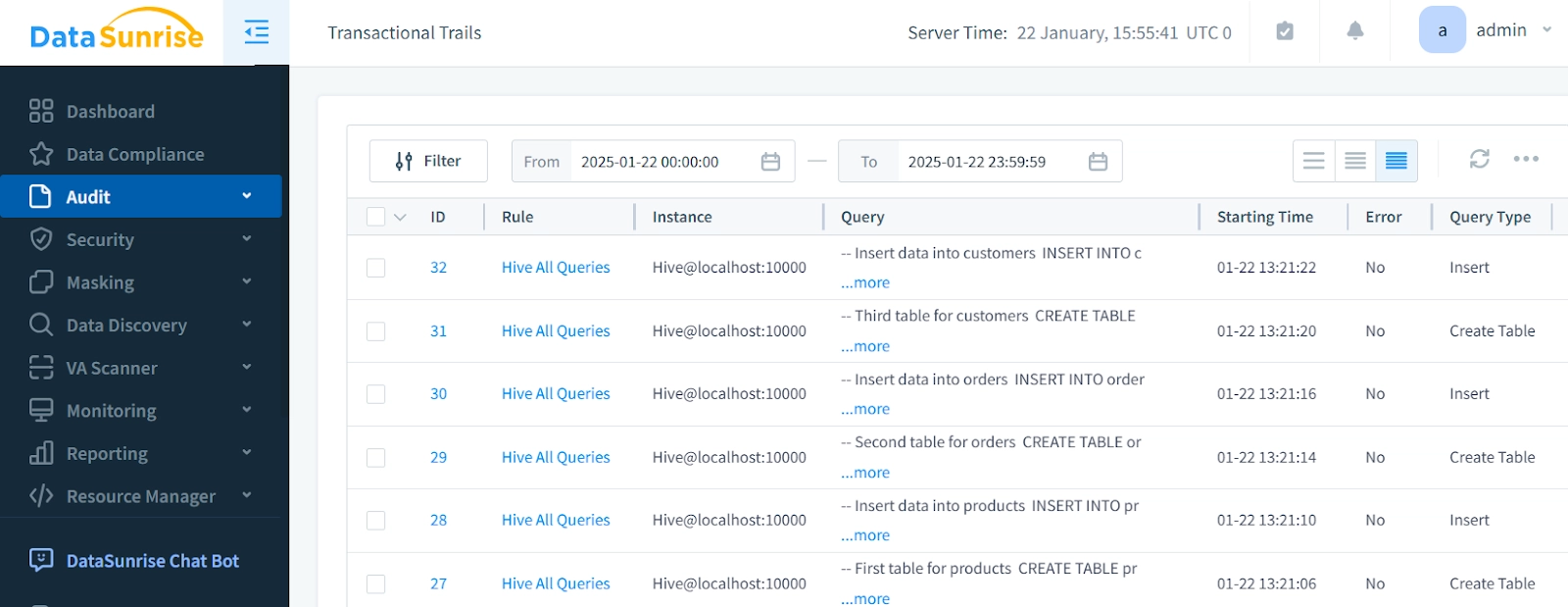
Key Features of DataSunrise for Hive Audit Trail
- Rich-context SQL query information, including user identity, query details, and access patterns
- Detailed session tracking with complete authentication and authorization data
- Efficient storage with intelligent event filtering and compression
- Enhanced visibility and reporting for audit trails and security compliance
- Minimal performance impact on Hive operations with smart event filtering
- Real-time audit event capture without log parsing overhead
- No modifications to existing Hive infrastructure
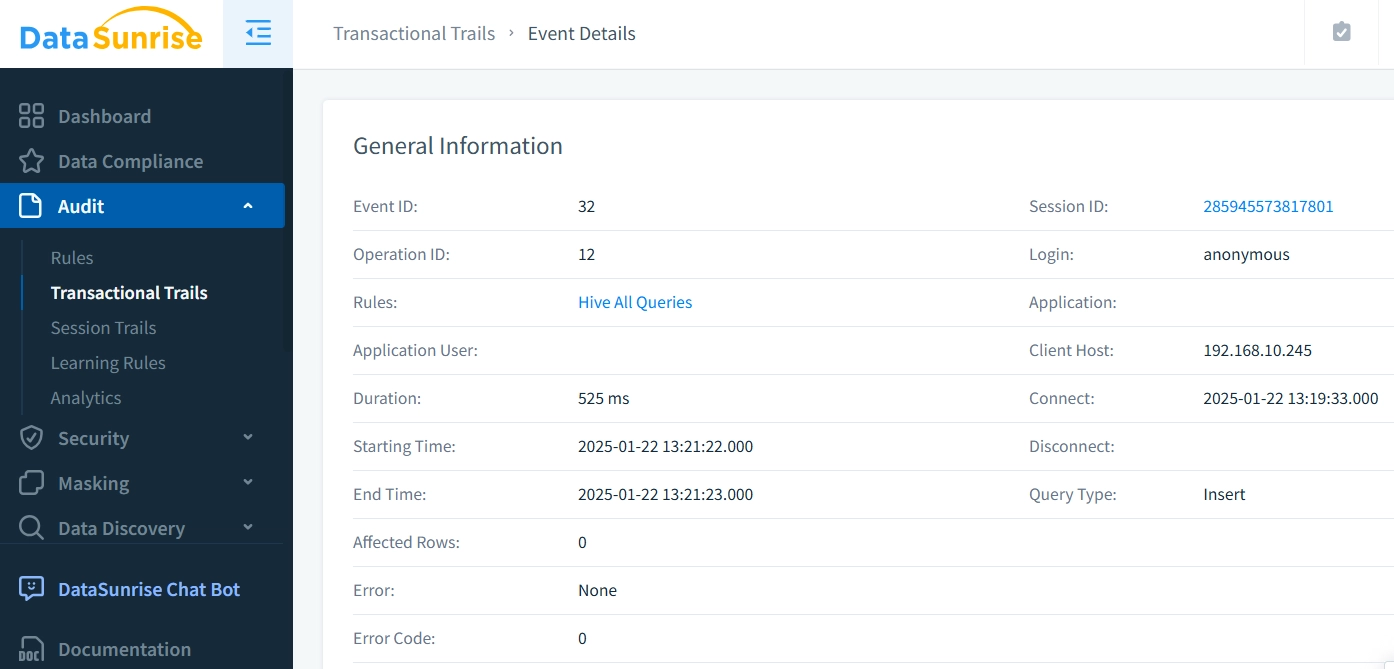
Additional Benefits
In addition to its extensive audit functionality, DataSunrise also offers a powerful suite of tools designed to enhance security, monitoring, and analytics for Hive and multiple other supported environments. Main benefits include:
- Automated Compliance Reporting: Generate detailed compliance reports for GDPR, HIPAA, and other regulations automatically.
- Real-Time Notifications: Receive instant alerts for critical events to facilitate an immediate response.
- Behavior Analytics: Identify unusual patterns and potential threats with advanced analytics.
- LLM and ML Tools: Leverage machine learning and large language models to strengthen security and enhance monitoring capabilities.
Conclusion: Strengthening Your Hive Audit Trail Tracking
In summary, implementing a robust Hive audit trail is crucial for maintaining data security, ensuring regulatory compliance, and enhancing operational transparency. While Hive's native audit trail provides a basic level of tracking, organizations seeking more advanced auditing capabilities can benefit greatly from tools like DataSunrise.
DataSunrise not only builds upon Hive's native features but also offers real-time monitoring, centralized log management, dynamic data masking, and automated reporting tools, delivering a more sophisticated solution for data protection and audit trails.
If you want to enhance your Hive environment with advanced audit features, schedule a demo today and take your data security and compliance efforts to the next level.
